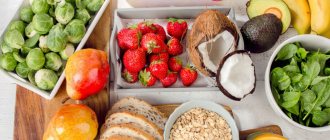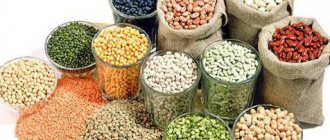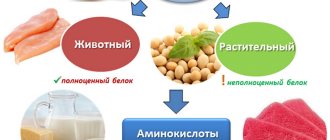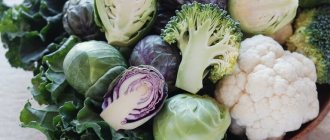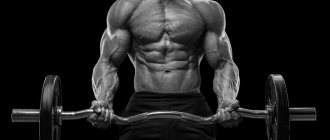Daily protein intake
Each person needs an individual amount of protein daily. It depends on gender, weight and other factors. It is important not to overdo it and not eat only protein-rich foods. In any case, nutrition should be balanced and rational. Eating too much protein will not lead to increased muscle growth, although some people believe it will. Even 300 grams of pure protein per day will not cause the body to produce muscle tissue faster than possible.
Research says that for athletes and people who are trying to gain weight, the protein norm is equal to 1.5-2.5 g per 1 kg of weight. That is, with a weight of 70 kg, a man needs about 200 g of protein, a woman with a weight of 60 kg needs 165 g per 1 kg of weight. For weight maintenance or weight loss, this value is reduced by 10% or 20% respectively. But do not forget that this is purely individual, and you should rely on your feelings, observing changes in your figure and well-being. It is impossible to understand from the first day whether the diet has been chosen correctly; at least a month must pass, after which you can adjust your diet.
List of Protein Rich Foods
Not all foods have the same nutritional value and calorie content, and, accordingly, the amount of protein. Animal products (meat, fish, poultry), legumes, cereals and other products are richest in it. Proper protein nutrition for muscle growth is built on protein-rich foods; there are recipes for dishes (for example, boiled chicken fillet with lentils) that are considered “impact” dinners for athletes. With one such meal, you can reach the normal amount of protein consumed. Eating such food is best in the evening, since fats are too heavy for the digestive system and digestion during sleep, and carbohydrates provide energy that is absolutely not needed at night; consuming carbohydrates at night will only lead to the gain of fatty tissue, not muscle tissue. Let's find out which foods contain protein
10 foods with the highest protein content
There are foods that contain practically no protein, such as sweets and desserts; such dishes are not eaten on a protein diet, but there are record-breaking foods for protein content. It is on the basis of this food that proper protein nutrition is built.
List of foods rich in protein:
- Soy – up to 35 g;
- Boiled veal – up to 31 g;
- Peanuts – 26 g;
- Chicken breast – 25 g;
- Tuna – 23 g;
- Beans and peas – 22 g;
- Cheese – 19 g;
- Shrimp – 18 g;
- Cottage cheese – up to 17.5 g;
- Chicken egg – up to 14 g.
From this list it is clear that not only animal products are rich in protein, but also plant-based ones. This means that vegetarians, vegans, and other people who follow certain diets for moral reasons or health reasons can keep their body in good shape and build muscle, despite the fact that there is a popular myth about the lack or absence of protein in plant foods.
Such a variety of products allows you to combine them with each other and create more and more new dishes that will help diversify the menu even on a protein diet.
Fast and slow proteins: what foods contain them
There are several classifications of protein foods. The most common of them is by origin (animal or plant), but proteins can also be divided according to the speed of absorption:
Slow. It takes 6-8 hours to break them down into amino acids. These substances contain fewer calories and require more energy to digest, so they are most effective for weight loss and reduce hunger for a long time. They are found in plant foods.
Fast. Absorbed in just 1-1.5 hours. Due to the speed of absorption, they allow you to quickly gain energy and vigor, and help to gradually gain muscle mass. The list of such products includes a variety of foods of animal origin.
The absorption coefficient in the table is calculated taking into account the incoming amino acids and the efficiency of digestion of this food. The higher the value of this characteristic, the more saturated source of protein the food is.
To build muscle mass, it is better to use products containing protein from the “fast” part of the list, and to lose weight – from the “slow” part of the list. For better assimilation of dishes, both types require additional preparation. For example, it is better to soak grains and grains before eating. And meat and fish are digested most efficiently if they undergo moderate heat treatment and grinding.
Protein compatibility
However, without the goal of building muscle, you should not combine high-protein foods very often. To process proteins from different sources, gastric juice of different acidity and different enzymes are needed. A constant combination of proteins + proteins will lead to some problems with the gastrointestinal tract, for example, the process of breaking down starch may be disrupted.
A combination of proteins and carbohydrates is not the best option, since the digestion of carbohydrates occurs in an alkaline environment, and proteins in an acidic environment with a high pH. Mixing these two substances leads to fermentation of foods, heartburn, heaviness and general malaise.
It is best to combine proteins with vegetables that contain little starch, as this also inhibits the digestion of food. These are vegetables like
- Cabbage;
- Radish;
- Bell pepper;
- Celery;
- Zucchini;
- Tomatoes;
- Spinach and other salads.
Thus, if necessary, you can occasionally correct the lack of protein with a combination of two or more high-protein foods, but in ordinary life it is better to replace such a combination with protein + fiber, that is, non-starchy vegetables.
Meat protein table
Different types of meat have different amounts of protein. In particular, meat protein is distinguished by its high content of amino acids, which practically do not decompose during heat treatment.
| Protein content in meat products | |||
| Veal | Up to 31 g | Pork lean | 25 g |
| Goose | 29 g | Mutton | 21-24 g |
| Chicken (no skin) | 25 g | Rabbit / hare | 24 g |
| Turkey | 24 g | Chicken stomachs | 20-22 g |
| Smoked sausage | ≈20g | Duck stomachs | 19.5 g |
| Beef | 19-23 g | Lamb liver | 19 g |
| Chicken liver | 18-21 g | Beef liver | 17 g |
| Chicken heart | 15-22 g | Beef tongue | 16 g |
| Pork liver | 18 g | Lamb heart | 15 g |
| Duck | 17.5 g | Lamb kidneys | 14 g |
| Beef/pork heart | 15 g | Beef kidneys | 12.5 g |
| Pork kidneys | 14 g | Boiled sausage | 10-12 g |
Fish and seafood proteins
| Protein content in fish, fish and seafood | |||
| Chum salmon caviar | 27 g | Beluga / Cod liver | 24 g |
| Sardine | 23.7 g | Tuna | 23 g |
| Mullet | 21.4 g | Pike-perch / Pink salmon / Bream | 21 g |
| Carp | 19.9 g | Sea bass / Shrimp / Saberfish | 20 g |
| Whitefish | 19 g | Saira | 18.6 g |
| Crabs | 18.7 g | Horse mackerel | 18.5 g |
| Ide | 18.2 g | Pike / Mackerel / Salaka | 18 g |
| Squid | 18 g | Shrimps | 17.8 |
| Flounder | 16.1 g | capelin | 13.4 |
| Cod | 17.5 g | Herring | 17.3 |
| Blue whiting | 17.9 g | Pollock / Sterlet / Catfish | 17 |
| Icy | 17.4 g | Sturgeon | 16.5 |
| Salmon | 20.8 g | Hake | 16.6 |
| Trout | 15.5 g | Oysters | 14 |
| Lamprey | 15 g | Canned fish in tomato | 12.8-19.7 g |
| Canned fish in oil | 17.4-20.7 g | Canned fish in its own juice | 20.9-28.7 g |
Milk proteins
| Protein content in dairy products | |||
| Milk | 2.8 g | Yogurt | 5 g |
| Kefir | 2.8 – 3.0 g | Buttermilk | 2.5 – 2.7 g |
| Sour cream | 3.0 – 3.4 g | Cottage cheese 20% | 14 g |
| Ryazhenka | 3.5 g | Smoked sausage cheese | 23 g |
| Curdled milk | 2.2 g – 2.8 g | Powdered milk | 25.6 g |
| Hard cheese | 25-35 g | Skim cheese | 16 g |
| Processed cheese | 20 g | Cream | 3.0 – 3.2 g |
| Ice cream | 3.5 g | Condensed milk | 8 g |
| Ayran (tan) | 2 g | Cheese Brynza | 17.9 g |
| Adyghe cheese | 18.5 g | Goat cheese | 22 g |
| Cheese Tofu | 8.1 g | Sulguni cheese | 20 g |
| Baked milk | 2.9 g | Goat milk | 3.6 g |
| Kumis | 2.1 g | Matsoni | 2.8 g |
| Butter | 0.9 g | Goat curd | 16.7 g |
Cereals
Detailed table with protein content in products
| Protein content in cereals, porridges, cereals and legumes | |||
| Bulgur | 12.3 g | Chickpeas | 20.1 g |
| Peas | 21.5 g | Oat groats | 11.9 g |
| Buckwheat | 13.5 g | Cereals | 11.7 g |
| Buckwheat flakes | 9.0 g | Pearl barley | 9.3 g |
| Quinoa | 14.1 g | Spelled | 14.7 g |
| Porridge 7 grains | 12.0 g | Sprouted wheat | 7.5 g |
| Corn grits | 8.3 g | Wheat groats | 11.5 g |
| Cornflakes | 7.4 g | Soft wheat grains | 11.8 g |
| Dry couscous | 12.8 g | Durum wheat grains | 13.0 g |
| Flaxseed porridge | 32.3 g | Wheat flakes | 11.0 g |
| Semolina | 11.4 g | Millet porridge | 11.2 g |
| Rye flakes | 6.4 g | Millet cereal | 11.5 g |
| Raw white rice | 5.0-8.0 g | Rye (grains) | 9.9 g |
| Brown rice | 7.4 g | Sago | 1.0 g |
| Brown rice | 6.3 g | Grain sorghum | 11.8 g |
| Golden rice | 8.1 g | Wheat talkan | 11.5 g |
| Red rice | 10.5 g | Teff | 13.3 g |
| Polished short grain rice | 0.1 g | Oatmeal | 12.5 g |
| Rice flakes | 7.0 g | Triticale | 12.8 g |
| White beans | 21.0 g | Lentils | 27.3 g |
| Red beans | 23.0 g | Barley grits | 10.4 g |
| Barley groats | 10.0 g | Barley flakes | 9.8 g |
Protein Digestibility Chart
All protein - both animal and plant - has a different effect on the body, is perceived differently by it, and therefore is absorbed differently. It depends on the amino acid composition. More precisely, from the ratio of one type of amino acid to another. The body does not synthesize the necessary amino acids, but uses only what it comes with food. If one of the amino acids is missing for the assimilation of proteins, then the rest will not be used. Easily digestible protein includes animal protein; an exemplary example of digestibility is the chicken egg - its digestibility is close to 100%. It is difficult to obtain protein from plant foods due to the lack of diversity in the composition of amino acids; protein in cereals and fruits is absorbed worst of all, since there are not enough components for this.
| Digestibility of protein in various foods | |||
| Product Names | Amount of protein | Absorption rate squirrel (PDCAAS) | Protein absorption percentage |
| Egg | 12.7 g | 1.0 | 100% |
| Egg powder | 45.0 g | 1.0 | 100% |
| Serum | 2.9 g | 1.0 | 100% |
| Milk, kefir | 2.8 g | 1.0 | 100% |
| Cottage cheese | 16.7 g | 1.0 | 100% |
| Cheese | 25.0 g | 1.0 | 100% |
| Beef | 18.9 g | 0.92 | 92% |
| Pork (not fatty) | 16.4 g | 0.63 | 63% |
| Pink salmon | 21.0 g | 0.90 | 90% |
| Chicken (poultry) | 20.8 g | 0.92 | 92% |
| Wheat | 12.7 g | 0.54 | 54% |
| Oats | 11.9 g | 0.57 | 57% |
| Rice | 7.0 g | 0.55 | 55% |
| Buckwheat | 12.6 g | 0.66 | 66% |
| Beans | 22.3 g | 0.68 | 68% |
| Peanut | 26.3 g | 0.52 | 52% |
| Peas | 23 g | 0.67 | 67% |
| Soybeans | 34.9 g | 0.91 | 91% |
| Corn | 8.3 g | 0.60 | 60% |
| Rye | 10.7 g | 0.63 | 63% |
| Cottage cheese | 15.0 g | 0.84 | 84% |
| Beans | 21 g | 0.49 | 49% |
| White bread | 9.0 g | 0.97 | 97% |
| Whole wheat bread | 11.3 g | 0.92 | 92% |
| Lentils | 27.3 g | 0.84 | 84% |
| Red caviar | 31.6 g | 0.90 | 90% |
| Squid | 21.2 g | 0.90 | 90% |
| Mutton | 22.0 g | 0.90 | 90% |
| Salmon | 21.7 g | 0.90 | 90% |
| Rabbit meat | 24.0 g | 0.90 | 90% |
| Tuna | 23.0 g | 0.90 | 90% |
Signs of protein deficiency
A lack of protein in the body manifests itself as follows:
- An irresistible desire to eat a certain product
It happens that you have a strong craving for sweet, salty or sour foods and it’s impossible to cope with it. Not always, but in frequent cases it is closely related to a lack of proteins.
- Sharp pain in muscles or joints
If your neck or knee suddenly hurts for no apparent reason and in the absence of diseases, you need to check whether there is enough protein in your diet. The body stores a little protein in reserve, which is closely related to the functioning of muscles and joints. With its constant shortage, this reserve is spent, which means health problems arise.
- Problems with sleep and fatigue
The body replaces the lack of proteins with an additional portion of carbohydrates and sugar, but they are quickly processed, energy is thrown away, and after a while it is not enough. If you have insomnia, you can try to reduce the amount of sweets and focus on protein.
- Moodiness, irritability, bad mood and constant stress
After a certain period of a protein-free regime, the body is completely exhausted, and even carbohydrate energy surges cannot save it. This leads to general malaise and irritability.
Carbohydrates
These are the main energy suppliers. Their task is to help muscle fibers work normally. In addition, the element contributes to the normal metabolism of fats and proteins in the body.
The following varieties are distinguished:
- Simple. This category includes mono- and disaccharides - elements that have a simple structure. The main representatives are fructose, sugar, maple syrup, and sweets.
- Complex. They have a complex structure and are called polysaccharides. The main suppliers are legumes, vegetables, cereals, and durum pasta. They play a key role in the body and have a positive effect on all ongoing processes.
Knowing where carbohydrates are found in foods, you can achieve any goals. So, their share should be 40-60% of the diet if the goal is weight gain. If the goal is to lose weight, then the requirements are lower - 10-30%. In this case, the main emphasis should be on complex “representatives”.
Their excessive consumption leads to the accumulation of fat deposits, which negatively affects the figure. Lack is the path to weakness, bad mood, lethargy, fatigue and drowsiness.
It is recommended to eat foods rich in carbohydrates before two to four o'clock in the afternoon. Otherwise, unspent energy can be converted into unnecessary fat.
- Candies, sugar, marmalade, pasta, dates, raisins and jam - the volume of the element is 60-70 grams (based on 100 grams).
- Beans, bread, prunes, cakes, halva, chocolate, peas, apricots - 45-60 grams.
- Curd cheese, green peas, figs, grapes, potatoes, ice cream and bananas - 12-20 grams.
- Watermelon, apricots, peaches, oranges, blueberries, lemon, strawberries - 6-10 grams.
As already mentioned, your diet should contain complex carbohydrates. If we give a list of products containing proteins and carbohydrates of this type, then it is worth highlighting brown rice, cereals (primarily oatmeal and buckwheat), lentils, soybeans and mushrooms.
Let's summarize:
- When losing weight, this nutrient should be consumed 10-30% (no more), and when maintaining (gaining) weight - 40-60%.
- The menu should be filled with a complex type of element.
- Carbohydrate foods are taken before 2-4 pm.
- Eliminating or reducing the consumption of fast carbohydrates is only a plus.
Protein content of available foods
In order to eat right and healthy, you don’t have to spend a lot of money on it. What inexpensive foods contain protein? List of available high protein foods:
- Buckwheat;
- Chicken;
- Peanut;
- Peas and beans;
- Chicken eggs;
- Hard, processed or any other cheese;
- Cottage cheese;
- Lentils;
- Canned fish and any other products.
In any case, one nutritious meal high in protein and fiber will not cost more than a fast food snack, which will give the body nothing but empty calories and unhealthy fat.
Clear advantages over the Kjeldahl and Dumas methods
- The IR spectrometry method involves analysis without destroying the sample.
- There is no sample preparation, and you will get results within 20-40 seconds.
- When analyzing protein content using IR spectrometry, no consumables are needed.
- There is no need to specially train the operator - all operations here are extremely simple.
- You can use the device both in the laboratory and in production.
- The absence of precursors and harm to the environment eliminates the need to complete a large number of documents.
- Unlike the other two methods described, IR spectrometry does not involve the use of high temperatures.
| Designations | Kjeldahl | Dumas | IR spectrometry |
| Sample presentation | Destruction (burning) | Destruction (burning) | Without destruction |
| Sample preparation | Yes | Yes | Absent |
| Analysis time | 2-4 hours | 5 min (preparation – 1 hour) | 20-40 s |
| Need of consumables | Yes | Yes | Absent |
| Specialist training | High | High | Low or absent |
| Place of analysis | Laboratory | Laboratory | Laboratory or production |
| The need for precursors | Yes | No | No |
| Working with high temperature | Yes (420 ⁰С) | Yes (900 ⁰С) | No |
| Harm to the environment | High | Average | Absent |
Thus, with full knowledge of the capabilities and limitations of each method and an appreciation of the tasks and workload of their own laboratory, a manufacturer can select the most appropriate protein quantitation method and the appropriate equipment to perform it properly. This means proving the quality and setting the right price for your products.
Anar Rakhmetov, food technology group expert
LLC “HIMLABORREACTIV”
List of the healthiest protein foods
The most important thing in food is not only the protein content, but also the overall ratio of dietary fat, vitamins and nutrients. You cannot rely only on one positive point of a product; nutrition must be complete and varied.
Example of the most useful products:
- Cottage cheese – high calcium content
- Peanuts - healthy vegetable fats
- Tuna or any other fish - fish oil and omega
- Oatmeal or other porridge are slow carbohydrates that fill you up for a long time and provide a large supply of energy.
- Soy - a huge supply of vitamins B1, B2, B3, B5, B6, B9, C and omega-3 and omega-6 fatty acids
Barley groats
Photo source: pxhere.com
Barley contains 9.5% protein . Its soluble fiber helps lower bad cholesterol and prevents spikes in blood sugar levels. Therefore, this cereal is especially recommended for obese people. Its use enriches the body with a large group of vitamins, as well as substances that contribute to the excellent functioning of the gastrointestinal tract.
Interesting to know! From barley groats you can make not only porridges, but also decoctions that gently envelop the stomach and relieve irritation of the mucous membrane.
The importance of protein for the body
View this post on Instagram
The bamboo shoots that pandas eat contain 2.6 grams of protein for every 100 grams. We bet you that pandas would grow even bigger if they knew which foods contained a lot of protein. Find out what to include in your diet to safely call it “high-protein” (naturally, on our website


